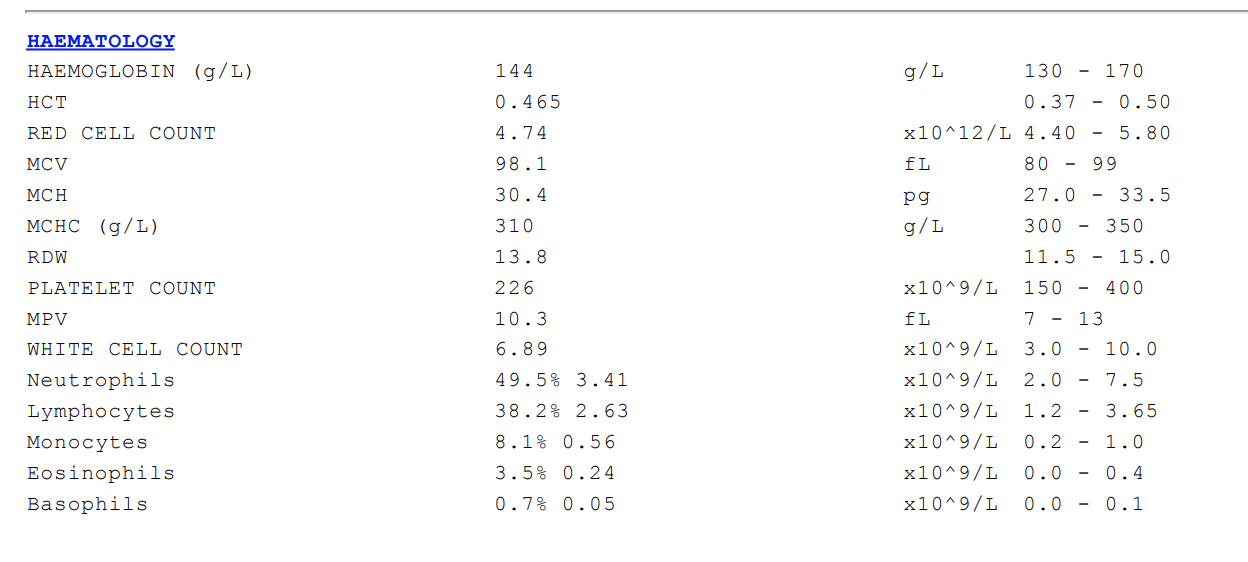Full Blood Count
What is Blood and a Full Blood Count?
Essential to life, blood travels around the body delivering oxygen and nutrients to the cells of all tissues and organs, while transporting the waste products of cell processes away from those cells to the lungs, kidneys and skin for elimination from the body.
Blood has both a solid (red blood cells, white blood cells and platelets) and fluid (plasma) part. The blood cells may also be called corpuscles. The liquid plasma forms over half of the blood. Plasma is mostly water but also contains proteins, sugars, salts, and hormones, which it transports to the cells of the body.
Red blood cells (RBC; known as erythrocytes) comprise 40%-45% of the blood, and carry oxygen around the body. White blood cells (WBC; leukocytes), which comprise approximately 1% of the blood, form part of the body's immune system and fight infection. Platelets (thrombocytes) are formed from fragments of certain cells; they help with blood clotting at the site of blood vessel damage, where they form a plug. RBC, WBC, and platelets are formed from stem cells, special cells in the bone marrow, where they are made continually.
A full blood count, often shortened to FBC, is one of the most common tests performed. It details important information about the cells in your blood, indicating the state of your health. While the FBC may point to certain causes of poor health, it generally is not a conclusive diagnostic test, and you may require more tests.
What is checked in a Full Blood Count?
The FBC takes various measurements of and within the blood cells. These include:
- A count of the number of RBCs, WBCs, and platelets per unit of blood.
- Haemoglobin concentration that is a measure of the amount of haemoglobin in RBCs.
- Haematocrit that is a calculation of how much of the blood is made up of RBCs
- Mean cell volume (MCV) that is a measure of the average RBC size.
- Red cell distribution width (RDW) that is a measure of the difference in the volume and the size of RBCs
- Mean cell haemoglobin (MCH) that is a measure of the average amount of haemoglobin within one RBC.
- Mean cell haemoglobin concentration (MCHC) that is a calculation of the amount of haemoglobin in one unit volume within one RBC.
There are 5 different types of white blood cells: neutrophils (40-70% of all WBCs), lymphocytes (20-40%), monocytes (2-8%), eosinophils (0-6%), and basophils (less than 1%). A cell count, known as the differential WBC count, of each of these WBCs is also included.
Why is a Full Blood Count important?
A FBC is important for several reasons. A FBC can be used as part of a routine medical examination to monitor the state of your general health, and to screen for a wide variety of medical conditions. It can be used in the diagnosis of a medical disorder by indicating the cause of any signs and symptoms that you may have, such as tiredness, inflammation, infection, bleeding, and bruising. It can also be used monitor a diagnosed medical disorder if it affects the numbers of RBC, WBC, and/or platelets. Finally, the FBC can monitor any medicines that you are taking, particularly if they are known to affect the numbers of blood cells.
Who should monitor their Full Blood Count?
If you have unexplained signs and symptoms such as fatigue or lack energy, inflammation, an infection, bruising, or bleeding, then you need to have a FBC to help the doctor in making a diagnosis. Further tests may be necessary to identify the cause of the problem. For example, a FBC may indicate a low RBC count (anaemia) but examination of RBC size and blood iron level may be required to determine that an iron deficiency is the cause. A medical condition or a medicine that is known to affect the blood cells may also be used to monitor your condition and make any changes to your treatment. In both the absence and presence of a medical condition and medication, a FBC is generally among the routine medical health tests that check your general health and screen for a range of disorders.
How to test for a Full Blood Count?
A blood sample from a vein is needed to carry out a Full Blood Count. The Online Clinic has partnered with Superdrug to provide a national blood draw service for tests such as this where a large volume of blood is required for an accurate result. Self-collect samples are not valid for the Full Blood Count.
Test results will go to your doctor at The Online Clinic who will explain what they mean.
What are normal Full Blood Count test results?
The RBC, WBC and platelet measurements taken from your FBC are compared with those in a set of normal laboratory values, collected from healthy people. Normal ranges provide a guide only, and each test result must be interpreted with reference to your signs and symptoms. There may be slight variations in the normal ranges used at different laboratories, and with each individual's characteristics such as age, sex, and pregnancy.
Here is a sample lab report:

What do Full Blood Count test results indicate?
The FBC will indicate whether you have RBC, WBC and platelets counts within or outside of the normal range. Abnormal counts may be higher counts than normal (too many cells) or lower counts than normal (too few cells). The amount of haemoglobin that is inside RBCs is reflected by the state of the RBC measurements.
A low RBC count (or low haemoglobin level) means that you have anaemia, which has many causes such as iron and vitamin deficiencies, an underlying medical condition, or blood loss. In the case of an iron deficiency anaemia, the average RBC size is smaller than normal because iron is needed to make haemoglobin. Symptoms of anaemia include extreme tiredness, lack of energy, feeling faint, and pale skin.
A high RBC count (or high haemoglobin levels), known as polycythaemia, may mean an underlying medical condition such as polycythaemia vera (a blood cancer), or lung or heart disease. Symptoms of polycythaemia include headaches, blurred vision, high blood pressure, and red skin.
A low WBC count, generally known as leukopenia, may be the result of an ongoing infection, a bone marrow disorder, an autoimmune disorder, cancer, or some medications such as immunosuppressants. Symptoms of leukopenia include fever, sweats, and swollen area of the body.
A high WBC count, known as leukocytosis, may be caused by infection, inflammation, an immune system disorder, a bone marrow disorder, cancer (such as leukaemia and lymphoma), or an allergy/allergic reaction. Symptoms of leukocytosis include fever, fatigue, pain, and unexpected body weight loss.
Abnormal WBC counts will reflect changes in one or more of the WBC types (a decrease is denoted by '-penia' and an increase by '-philia' or '-cytosis'). For example, neutrophilia, lymphocytosis, and eosinophilia may suggest a bacterial infection, a viral infection, and asthma/eczema, respectively.
A low platelet count or thrombocytopenia may be caused by an autoimmune disease, bone marrow disease (e.g., a myelodysplastic syndrome), chemotherapy, or alcoholism. Symptoms of thrombocytopenia include bruising and bleeding easily, and prolonged bleeding.
A high platelet count, known as thrombocytosis, may be the result of a disorder of platelet-producing bone marrow cells, infection, inflammation, underactive spleen, or chemotherapy. Symptoms of thrombocythemia include those related to bleeding and blood clots, such as light-headedness, weakness, chest pain, and numbness/tingling of hands/feet.
How to maintain or achieve good Full Blood Counts
A healthy lifestyle, including diet, regular exercise, and avoiding excess alcohol, and addressing any health problems is fundamental to good overall body functioning including that of the blood cells. A healthy diet including all vitamins and minerals is essential to avoid a nutritional deficiency that may affect blood cell production and function. An iron, folate or vitamin B12 deficiency may affect RBCs because it is used in haemoglobin production, and alcohol can adversely affect RBC production, while a diet rich in omega-3 polyunsaturated fatty acids can help to reduce platelet aggregation, modifying the progression of cardiovascular disease. Frequently, an underlying disorder needs to be treated with medicines, but these are things that you can do to help maintain normal blood cells.
GMC registration number: 4524038

Date: 1 March 2024
Next review: 28 February 2026
All UK registered doctors can have their registration checked on
The Medical Register at the GMC website.
Full Blood Count Reviews By Our Patients
-
Had initial concerns but the Online Clinic showed a level of care I can really appreciate
-
Excellent and quick service.




